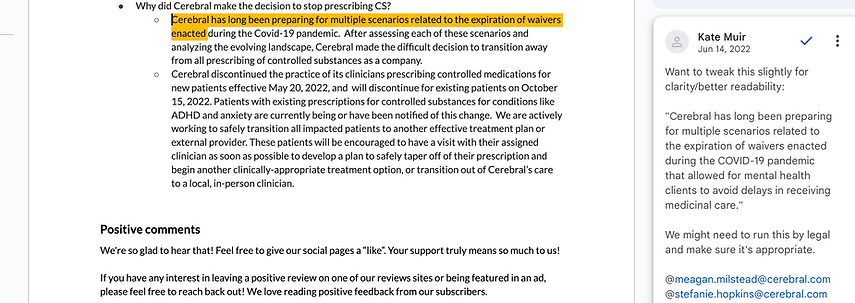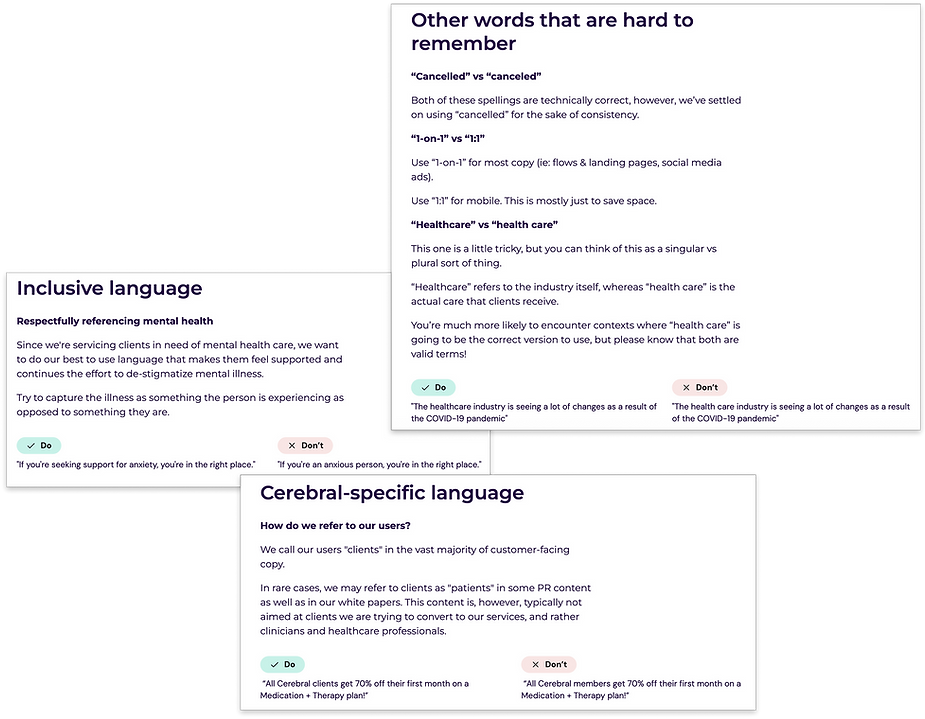Cerebral
Style guide
Here's a few pieces from the style guide I created (from scratch!) for Cerebral.
You can view the full guide here.
My roles
UX Writer, Technical Writer, Content Manager
Collaborated with
Product Designers, Legal, Marketing, Clinical leadership
Duration

Oct 2021–Apr 2023 (1 year, 7 months)
Impact
-
100% adoption across all channels
Challenge
Cerebral had no content style guide when I was brought on in 2021. We also had a lot of outdated language and information that was housed across multiple platforms, from CMS to google docs.
One of my core responsibilities as a founding content designer was to help designers, product managers, marketers, and fellow content creators maintain voice, tone, and language consistency in all deliverables across the org.
Solutions and process
To establish and socialize voice and tone, grammar, formatting, and general writing principles with all relevant departments, I did the following:
-
Audited existing content across the platform (UI microcopy, white papers, marketing materials, customer support templates) to identify inconsistencies and legacy patterns
-
Identified all software and CMS platforms where frequently-used content (support templates, emails, SMS) was housed
-
Interviewed writers, designers, marketers, legal, and support teams to understand current pain points pertaining to language and consistency
-
Defined core voice principles based on brand values and user needs
-
Created a tone map to guide relevant shifts across different product contexts and emotional states
-
Documented standards for microcopy, including buttons, errors, and labels
-
Established grammar, formatting, and style rules to ensure clarity and consistency
-
Developed a shared vocabulary and taxonomy to unify naming conventions and reduce ambiguity
-
Integrated accessibility and inclusive language best practices throughout the guide
-
Built a living document in Zeroheight and shared it across teams
Approach
Identifying what we already had vs. what we needed.
Shortly after I was onboarded, I met with the only other person at the company (a copywriter on the marketing team) who wrote and maintained content.
We had regular 1:1's to determine what guidelines were currently in place that we could continue to use for all copy moving forward. There was not much aside from some branding guidelines that mapped out a voice and tone for Cerebral.
Since this voice and tone was vetted and approved by clinical leadership, who know Cerebral's user base best (mental health), we made the choice to keep these while creating new guidelines for the following:
-
Grammar
-
Formatting (sentence case, oxford comma use, numbers and dates)
-
Language and taxonomy (terms to use and not use, how to write inclusively, etc)
-
Microcopy (CTAs, labels, error states)
-
Contextual use cases for tone shifts (ie, marketing copy vs. UX copy)
A very rough, early outline

Socializing the style guide
My earliest attempt to do this involved an instructional walkthrough of the guide, which at the time was housed in Google Slides, during a company All Hands.
This worked for making the rest of the company aware that these guidelines existed and should be utilized for all copy moving forward. However, there was still a need to develop a plan to ensure that the guidelines were actually followed.
To assist with this, I did the following:
-
Pinned the style guide to each appropriate Slack channel that included those who wrote copy
-
Documented any and all changes and updates and presented to our design team during weekly stand-ups
-
Put aside 1 hour a week for office hours where anyone could come in with questions about content guidelines or who were looking for general writing tips

Some slides from the earliest version of the style guide. These were later expanded upon to include other contexts, such as clinician-facing and B2B-facing
Auditing strings, templates and other content types for consistency
One of the toughest parts of maintaining the guidelines were identifying all of the different content management systems teams were using for content like:
-
Emails
-
SMS notifications
-
Support scripts and messaging
-
Marketing blurbs
-
Microcopy
I worked with my fellow designers, marketing leaders, product managers, and clinicians to gain access to these systems and audit as needed to ensure style guide adherence. I did this within:
-
Iterable (used for marketing and emails)
-
Google Docs (used by marketing and support for messaging templates)
-
Figma (used by our designers for components that include microcopy)
-
Contentful (used specifically to message customers in their accounts)

Some of my feedback on support scripts used for frequently asked questions from customers
The final product
General writing guidelines
These were created as a broad approach to writing copy for Cerebral. These 6 guidelines were intended to be followed across ALL contexts, regardless of target user group(s) and purpose.

Voice and tone
These defined the platform’s core voice (grounded, approachable, and compassionate), and outlined how tone flexes depending on user context, emotional state, and mental health acuity.

Tone map
I collaborated with marketers, clinicians, legal, and product managers to create a contextual tone map that guides teams on how to adjust messaging depending on where the user is in their journey.

Microcopy
These guidelines were created to standardize best practices for buttons, error messages, field labels, and helper text. The aim was to emphasize clarity, brevity, and emotional nuance, especially for sensitive moments in the product.

Microcopy components
I worked with each design lead across our 3 pillars, (Growth, Retention and EMR) to identify some of the most commonly used strings across the Cerebral platform. I designated the following categories for microcopy and included a definition, purpose, and instructions for use:
-
CTAs
-
Labels
-
Error states
-
Terms, conditions, and other “legalese”
-
Crisis-related
-
Contact us
-
Insurance
-
Memberships and payment
Ultimately, 93 reusable component strings were created and given a designated page in Cerebral’s Figma design system file. I tagged each appropriately so that they could be easily accessed by design team members in Figma's asset panel.


Grammar and formatting
Utilizing Plain Language guidelines, I outlined rules for punctuation, capitalization, spelling, numbers, dates, and other mechanics. This reduced inconsistencies and freed up mental space for writers and designers to focus on meaning.

Language and taxonomy
I worked primarily with clinical and legal stakeholders to develop a controlled vocabulary that reflects clinical accuracy without overwhelming or alienating users. This ensured the words we use are inclusive, accessible, and aligned with user mental models.
Working closely with members of our legal team also helped us to stay compliant with ever-evolving HIPAA and other regulations for telehealth treatment.

Design system and styling updates
The majority of our frequently-used UI components involving copy were housed in Figma’s design system. Many of these legacy components needed to be audited and edited to align with the new grammar and formatting guidelines specified in Zeroheight.
Some of the biggest changes myself and the Design Ops lead focused on were:
-
Ensuring all strings used sentence case rather than title case
-
Making updates to commonly used terminology to reflect Plain Language best practices (ie, swapping out terms like “ensure” for “make sure”)
-
Making updates to terminology to comply with ever-evolving legal and HIPAA guidelines for telehealth companies (ie, we could no longer refer to our clinicians as such in customer-facing copy, and all instances of this needed to be changed to “prescribers”)

Broader guidelines
Finally, I documented high-level principles that govern how we write and communicate across channels, such as social media marketing (Instagram, Facebook), B2B marketing, clinician-facing content, and customer support (within the platform and on TrustPilot).
Important to note: you may notice the content of these sections in the actual style guide are very sparse or not filled out at all. That's because my role was sadly made redundant before I got to expand upon them further :(

Reflections
Though I'm proud of this project, it's admittedly a bit old. Here are some things I would have done differently today:
-
Improvements to microcopy components in the design system
-
Specifically, I'd add instructions for use to each component, as opposed to an overarching rule for each category.
-
-
More of an emphasis on metrics
-
I would have attempted to create a more robust QA process for style guide maintenance that could be referenced and shown to stakeholders for impact purposes.
-
-
Utilization of GenAi tools
-
I would utilized prompt engineering reduce time spent defining specific patterns, generating "dos" and "donts" examples, and defining terminology.
-
I also would have attempted to train an LLM to write copy in accordance to the style guide as a way of helping other writers maintain language consistency, as well as improving my own workflow.
-